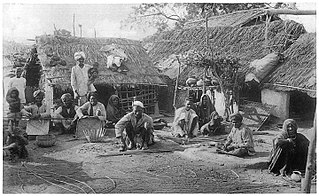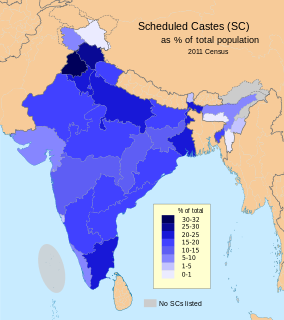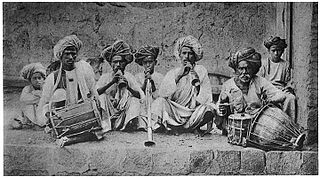
Caste is a form of social stratification characterized by endogamy, hereditary transmission of a style of life which often includes an occupation, ritual status in a hierarchy, and customary social interaction and exclusion based on cultural notions of purity and pollution. Its paradigmatic ethnographic example is the division of India's Hindu society into rigid social groups, with roots in India's ancient history and persisting to the present time. However, the economic significance of the caste system in India has been declining as a result of urbanization and affirmative action programs. A subject of much scholarship by sociologists and anthropologists, the Hindu caste system is sometimes used as an analogical basis for the study of caste-like social divisions existing outside Hinduism and India. The term "caste" is also applied to morphological groupings in female populations of ants and bees.
Jāti is a group of clans, tribes, communities, and sub-communities, and religions in India. Each Jāti typically has an association with a traditional job function or tribe. Religious beliefs or linguistic groupings may define some Jātis. Among the Muslims, the equivalent category is Qom or Biradri.

The Maratha caste was originally formed from the amalgamation of families from the agricultural castes in Maharashtra who took to military service under the various Muslim rulers and later in the armies of Shivaji and earned vatans and inams in return.

Mahatma Jyotirao Govindrao Phule, also known as Jotiba Phule was an Indian social activist, thinker, anti-caste social reformer and writer from Maharashtra.
Untouchability, in its literal sense, is the practice of ostracising a minority group by segregating them from the mainstream by social custom or legal mandate.
Dalit, meaning "broken/scattered" in Sanskrit and Hindi, is a term mostly used for the ethnic groups in India and Nepal that have been kept repressed. Dalits were excluded from the four-fold varna system of Hinduism and were seen as forming a fifth varna, also known by the name of Panchama. Dalits now profess various religious beliefs, including Hinduism, Buddhism, Sikhism, Christianity and various folk religions. The 2011 Census of India recorded their numbers at over 200 million people, representing 16 percent of India's population.
Mysore Narasimhachar Srinivas (1916–1999) was an Indian sociologist and social anthropologist. He is mostly known for his work on caste and caste systems, Social stratification, Sanskritisation and Westernisation in southern India and the concept of 'Dominant Caste'.

The Scheduled Caste (SCs) and Scheduled Tribes (STs) are officially designated groups of historically disadvantaged people in India. The terms are recognised in the Constitution of India and the groups are designated in one or other of the categories. For much of the period of British rule in the Indian subcontinent, they were known as the Depressed Classes.
The Mukkulathor people, who are also collectively known as Thevar, are native to the central and southern districts of Tamil Nadu, India. They comprise the Agamudayar, Kallar and Maravar social groups that share a common myth of origin and claim to have once been members of various ancient South Indian dynasties.

The caste system in India is the paradigmatic ethnographic example of caste. It has origins in ancient India, and was transformed by various ruling elites in medieval, early-modern, and modern India, especially the Mughal Empire and the British Raj. It is today the basis of educational and job reservations in India. The caste system consists of two different concepts, varna and jati, which may be regarded as different levels of analysis of this system.
Castes in Indian society refer to a social group where membership is decided by birth. Members of such local groups are endogamous, i.e. they tend to enter into marital relationships among themselves. They often have related political preferences.
Caste related violence has occurred and occurs in India in various forms. According to a report by Human Rights Watch, "Discriminatory and cruel, inhuman, and degrading treatment of over 165 million people in India has been justified on the basis of caste. Caste is descent-based and hereditary in nature. It is a characteristic determined by one's birth into a particular caste, irrespective of the faith practiced by the individual. Caste denotes a traditional system of rigid social stratification into ranked groups defined by descent and occupation. Caste divisions in India dominate in housing, marriage, employment, and general social interaction-divisions that are reinforced through the practice and threat of social ostracism, economic boycotts, and physical violence."
Ambalavasi (Ampalavasi) is a generic name for a group of castes among Hindus in Kerala, India, who render temple services. Some Ambalavasi castes are patrilineal, while the others are matrilineal. Those that practise matrilineality share many cultural similarities with the Nair caste. Their ritual rank in Hinduism lies somewhere between the Brahmin castes and the Nairs.
Sargodha Tehsil, is an administrative subdivision of the Sargodha District in the Punjab province of Pakistan. The tehsil is subdivided into 62 Union Councils - 22 of which form the city of Sargodha.
Kaniyar is a caste from the Indian state of Kerala. There are regional variations in the name used to define them. The Kerala Public Service Commission considers Kaniyar Panicker upper Classes]], and Kalari Panicker to be another.
The 1991 Nepal census was a widespread national census conducted by the Nepal Central Bureau of Statistics.
The Hawari (Qassar) are a South Asian community traditionally involved in washing clothes. They are considered to be Muslim converts from the Hindu Dhobi caste, and are found in North India and Pakistan. The community is also known as Charhoa and Gazar in Pakistan and Hawari(Qassar)in India.
The Kabaria, sometimes pronounced as Kabariya are a Muslim community found in the state of Uttar Pradesh in India, mainly in the Awadh region. A small number of Kabaria are also found in the Terai region of Nepal. They now have Other Backward Class status in Uttar Pradesh.

The Mang or Matang community is an Indian caste mainly residing in the state of Maharashtra. The community was historically believed to be associated with Village security or professions such as rope making, broom making, village musicians, cattle castration, leather curing, midwifery, hangmen, and undertaking. In modern day India, they are listed as a Scheduled Caste, Their origins lie in the Narmada Valley of India, and they were formerly classified as a criminal tribe under the Criminal Tribes Acts of the British Raj.
Nepal conducted a widespread national census in 2011 by the Nepal Central Bureau of Statistics. Working with the 58 municipalities and the 3915 Village Development Committees at a district level, they recorded data from all the municipalities and villages of each district. The data included statistics on population size, households, sex and age distribution, place of birth, residence characteristics, literacy, marital status, religion, language spoken, caste/ethnic group, economically active population, education, number of children, employment status, and occupation.







